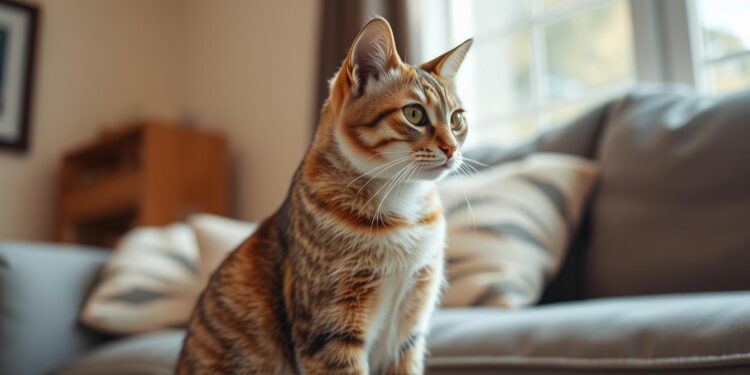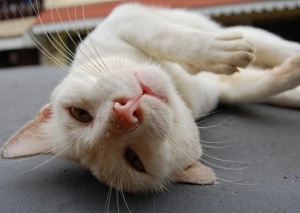Having a well-behaved pet is a joy to behold. However, achieving this can be a challenge, especially when it comes to disciplining your cat. Rather than resorting to physical punishment, it’s essential to understand that positive reinforcement is key to encouraging good behavior.
By providing alternatives, such as scratching posts or perches, you can discourage unwanted behavior and create a more harmonious home environment. Effective cat discipline techniques involve understanding your cat’s needs and using positive reinforcement to encourage good behavior.
With simple steps and a patient approach, you can help your cat become a well-behaved pet, strengthening the bond between you and your feline friend.
Understanding Cat Behavior
The key to disciplining a cat lies in understanding its behavior and psychology. Cats are often perceived as being aloof or independent, but this doesn’t mean they don’t respond to training or interaction. In fact, cats are highly intelligent animals capable of complex behaviors.
Cats differ significantly from dogs in terms of their behavior and interaction styles. Unlike dogs, cats are not pack animals and don’t have the same instinct to please their owners. However, this doesn’t mean they can’t be trained; it just requires a different approach. Understanding the source of misbehavior is crucial for correcting it.
Why Cats Develop Behavior Problems
Cats develop behavior problems for various reasons, including environmental factors, health issues, or lack of stimulation. For instance, a cat might scratch furniture due to boredom or anxiety. Identifying the root cause of the behavior is the first step towards correcting it.
The Unique Psychology of Felines
Felines have a unique psychology that is shaped by their evolution as predators. They have a strong instinct to hunt and play, which can sometimes be misinterpreted as aggression or hyperactivity. Understanding and catering to these natural instincts can help in reducing unwanted behaviors.
| Behavioral Trait | Description | Training Tip |
|---|---|---|
| Scratching | A natural behavior for cats to mark territory and sharpen claws. | Provide a scratching post to redirect the behavior. |
| Meowing | Cats meow to communicate needs or wants. | Respond to meowing appropriately to avoid reinforcing excessive meowing. |
| Hunting | Instinctual behavior that can be triggered by toys or stimuli. | Engage your cat in play to satisfy the hunting instinct. |
Common Misconceptions About Cat Training
One common misconception is that cats cannot be trained. However, with patience and the right techniques, cats can learn to behave well. Another misconception is that cats are not social animals; while they value independence, many cats are affectionate and enjoy human interaction.

By understanding cat behavior and psychology, cat owners can develop effective strategies for training their pets. It’s about recognizing their needs, providing appropriate stimulation, and using positive reinforcement techniques.
How to Discipline a Cat: Effective Techniques
Disciplining a cat requires patience, understanding, and the right techniques. Cats are not dogs and require a different approach to discipline. Understanding cat behavior and psychology is crucial in developing effective discipline strategies.
Positive Reinforcement: Rewards That Work
Positive reinforcement is a powerful tool in cat training. Rewarding good behavior encourages your cat to repeat it. Use treats, praise, and affection when your cat behaves as desired.
- Use small, tasty treats for immediate rewards.
- Praise your cat with positive, upbeat tones.
- Affection can be a powerful reward for many cats.
Redirecting Unwanted Behaviors Effectively
Redirecting unwanted behavior is another effective discipline technique. If your cat is scratching furniture, redirect it to a scratching post. Consistency is key; ensure all family members are redirecting the behavior in the same way.

Safe and Humane Deterrents
Deterrents can be useful in discouraging unwanted behaviors. Use safe and humane deterrents such as double-sided tape or spray deterrents on surfaces you don’t want your cat to scratch or jump on.
What Never to Do When Disciplining Your Cat
It’s equally important to know what not to do when disciplining your cat. Never physically punish or yell at your cat, as this can cause fear and aggression. Avoid using punishment-based training methods, as they can damage your relationship with your cat.
Addressing Specific Behavior Problems
Understanding and addressing specific behavior problems is crucial for a harmonious relationship with your cat. Cats exhibit a range of behavior problems, from furniture scratching to litter box issues, aggression, and excessive meowing. Effective cat training methods can modify these behaviors, improving the quality of life for both cats and their owners.
Stopping Furniture Scratching
Furniture scratching is a common issue in cats, driven by the need to mark territory and maintain claw health. To address this, provide your cat with appropriate scratching posts made of materials like sisal or cardboard. Place these posts near areas where your cat tends to scratch. You can also use cat behavior modification techniques such as double-sided tape or aluminum foil to deter scratching on unwanted surfaces.
Solving Litter Box Issues
Litter box problems can arise from various factors, including a dirty litter box, inadequate litter box size, or medical issues. Ensure the litter box is cleaned regularly and is large enough for your cat. Experiment with different litter types to find one your cat prefers. If problems persist, consult a veterinarian to rule out underlying health issues.
Managing Aggression and Biting
Aggression and biting in cats can be triggered by fear, pain, or overstimulation. To manage these behaviors, it’s essential to identify and address the underlying cause. Provide a safe and calm environment, and avoid physical punishment, which can exacerbate aggression. Instead, use positive reinforcement techniques to encourage calm behavior.
Reducing Excessive Meowing
Excessive meowing can be due to hunger, attention seeking, or medical issues. Ensure your cat’s basic needs are met, including regular feeding and attention. If meowing persists, it may be necessary to consult a veterinarian to check for health problems. Cat training methods such as ignoring the meowing or rewarding quiet behavior can also be effective.
By applying these cat behavior modification strategies, cat owners can effectively address common behavior problems, leading to a more harmonious and enjoyable relationship with their pets.
Conclusion: Creating a Well-Behaved Cat for Life
Creating a well-behaved cat requires patience, understanding, and the right techniques. By applying the principles outlined in this article, cat owners can develop a strong, positive relationship with their pet.
Training a stubborn cat demands consistency and positive reinforcement. By using rewards and redirecting unwanted behaviors, cat owners can achieve a harmonious household.
With the techniques and strategies outlined in this article, cat owners can address specific behavior problems, such as furniture scratching and litter box issues, and create a well-behaved cat for life.










